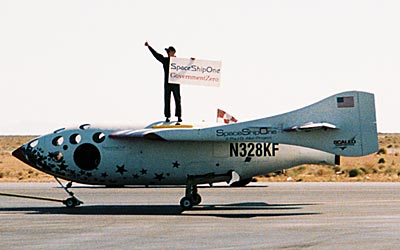The future starts hereby Derek Webber
|
| The SpaceShipOne flight rekindled the interest of ordinary folks in space flight. Around 20,000 people turned up before sunrise in a hick town in the middle of nowhere to see the spectacle. |
Look at some other contrasts. Burt Rutan’s equivalent of the Mercury control room was a mobile trailer. Back in 1961, the fuel was kerosene with liquid oxygen as oxidizer, which meant that nobody except the astronaut was within miles of the vehicle during the countdown to launch, unless they were in concrete bunkers. Melvill’s spacecraft has a new hybrid rocket engine that uses rubber and laughing gas, a combination of fuel and oxidizer so inherently safe that his White Knight mother plane taxied right by the crowd on his way to take off, with SpaceShipOne suspended beneath.
The spacecraft itself was dramatically different in construction from those of the sixties. Composites have replaced exotic metals. The crew cabin of SpaceShipOne seems to consist of more holes than structure to ensure a good view for crew and passengers, and the pilot can even stick his hand out to wave to the crowd on passing by to take off. Mercury, by comparison, was a sealed capsule with very little external visibility, and no room for the astronaut to move. This new strange-looking bird with its spindly legs is a totally new kind of spacecraft, even though it looks an unlikely harbinger of great change. It is reusable and can take off again for space with a turnaround of a few days. All of the Mercury capsules were used once and then ended up in museums like the Smithsonian.
Perhaps even more dramatic to note is the comparison between the image represented by Shepard in his shiny full pressure spacesuit (which almost defined the term “astronaut”), and an almost casual Melvill in his regular flight suit overalls. Ten minutes after returning from space, Melvill could jubilantly climb on his craft and be towed in front of the crowd. It really makes you think.
There are contrasts, too, between the old US Air Force-managed Cape Canaveral and the new civilian Mojave Spaceport. This was an inland launch from a commercial airport and everything took place in the skies above the spaceport. The essential image of Canaveral is its row of gantries, lining the ocean; Mojave has no gantries. It has no high-energy LOX and propellant storage bunkers, or blockhouses, either. Facilities for the public at Mojave on June 21st were a bit basic, and will need to improve at all spaceports, because this new era of space flight will succeed or fail depending on the way the public perceives the experience. There will be some exciting changes ahead at spaceports as the new industry develops.
| The new space era reverts to essential American values: having fun, taking risks, pushing frontiers, and trying to make a buck. |
Of course, the main contrast, and the key to all the other changes, is the source of funds. SpaceShipOne flew into space without recourse to government funds. So, this new era depends on the development of the new business of public space travel, and relies upon projections of numbers of the public who want to be space tourists. If the surveys are correct, then up to 15,000 space tourists per year want to take a suborbital flight at up to $100,000 per flight. Entering the field at Mojave on June 21st, I passed a solitary Stars and Stripes flag stirring in the early breeze, illuminated dramatically as the desert sun began to rise over the distant mountain range, and it underlined that what was about to happen was a truly American endeavor. The new space era reverts to essential American values: having fun, taking risks, pushing frontiers, and trying to make a buck.
Burt Rutan signaled his intentions clearly enough on December 17th, 2003, the centenary of the Wright Brothers’ first flight at Kitty Hawk, when he sent Spaceship One to 68,000 feet at Mach 1.2. Now he and his team have achieved the first civilian designed, built, financed, and piloted trip into space. He intends to continue to change the aerospace world, and has been talking about a wild ride. He is headed to orbit and beyond. And he will do it taking us with him, which is the biggest, and most enabling, change of all. Twenty thousand people, who in the early dawn saw SpaceShipOne going like a bat out of hell into space in the blue skies above Mojave, not only experienced an inspiring historical moment, but observed the true beginning of the new space era, a turning point for mankind.
